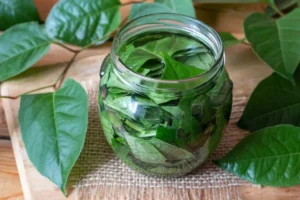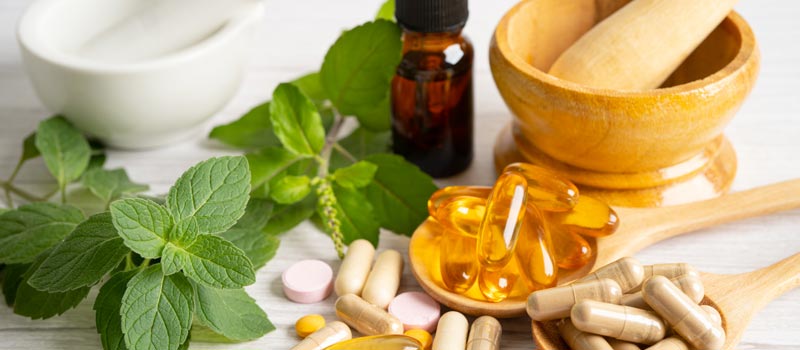Natural Remedies for Lyme Disease
Natural remedies are extremely useful in acute and chronic lyme cases.
It’s important to understand their role when you embark on a Lyme treatment journey. This article will offer insight into some of the most effective natural remedies for Lyme disease, along with how they should be used. This helps speed up your recovery while reducing the chances of complications.
Why Natural Remedies Play a Role in Lyme Treatment
Natural remedies offer relief to Lyme patients and address issues that antibiotics couldn’t catch. Sometimes, antibiotics are not enough, which leaves natural remedies to pick up the slack.
Natural remedies also support the body, helping it expel the pathogen naturally.
When Antibiotics Aren’t Enough
According to studies led by Gwenn L. Skar at the University of Nebraska Medical Center, an average of 10% to 20% patients do not recover from their first round of antibiotics.
Even after 6 months post-treatment, they experience a variety of symptoms such as:
- Ongoing fatigue
- Muscle pain
- Cognitive dysfunctions
- Insomnia
- Headaches
These symptoms persist despite completing a full course of antibiotics. They suggest a hidden infection or an unresolved immune dysfunction if they last more than 6 months.
Antibiotics fail to suppress the Borrelia burgdorferi bacteria, causing them to become resistant and hide in the tissue. Co-infections make matters worse, delivering gradual doses of bacterial load that trigger the immune system.
Integrative care is the solution, as it supports the body rather than merely attacking the pathogen. This calms potential inflammation and restores the immune system. In the long term, this helps prevent or treat the symptoms of chronic Lyme disease.
Herbs and Botanicals with Antimicrobial Properties

Herbs and botanicals with antimicrobial properties include essential oils, anti-persisters, and immune-modulating herbs. These break through bacterial defenses and reduce the impact of Borrelia burgdorferi. This eventually promotes long-term recovery.
Essential Oils for Borrelia Support
Popular essential oils used for Borrelia support include oregano oil, cinnamon bark, garlic, and thyme. These are known for their antimicrobial effects and ability to support the body. Essential oils also break or disrupt bacterial biofilm, reducing antibiotic resistance.
Studies led by Anna Goc at the Dr. Rath Research Institute show that the right essential oils eradicate Borrelia burgdorferi by up to 30%. This adds strength to antibiotics, especially when used in the early stages of treatment.
Below are the clinical uses of some of the most common essential oils used to treat Lyme:
- Cinnamon Bark Oil: It is rich in cinnamaldehyde, with the essential oil featuring about 90%. This active agent is a potent antibacterial and antifungal. Research shows in vitro activities against Borrelia burgdorferi and co-infections such as Babesia.
- Clove Oil: This substance has high contents of eugenol. Studies at the Johns Hopkins Bloomberg School of Public Health show that clove oil can kill Borrelia bacteria in their stationary phase, which is the most persistent.
- Thyme Oil: This essential oil is particularly effective because of its antiviral, antimicrobial, and antifungal properties. Naturopaths use it to disrupt Borrelia biofilm in patients with chronic Lyme infection.
- Garlic Oil: Garlic is an effective antifungal, antibacterial, and antiparasitic agent that has a long history of fighting pathogens. The allicin in garlic has shown great potential for inhibiting the growth of Borrelia Burgdorferi. Studies at George Washington University Health Care Sciences show that garlic reduces chronic Lyme if administered 4 to 14 days post-infection.
Essential oils are potent and have to be diluted correctly for safe administration. Qualified practitioners know how much is needed based on the symptoms and the status of your illness. Oils can do more harm than good if they are used undiluted.
Anti-Persister and Immune-Modulating Herbs
Anti-persisters such as cat’s claw, Japanese knotweed, sweet wormwood, cryptolepis, and Chinese skullcap improve immune response. The immune system responds directly and starts the immune regulation process.
The herbs also target pathogens that hide in the tissue or are protected by a biofilm. This makes them effective for antibiotic-resistant strains, as well as for potential Lyme disease co-infections.
Below are the most common anti-persisters and immune-modulating herbs, along with their multi-targeted effects:
- Japanese Knotweed: Known for its anti-inflammatory effect and ability to break through biofilm.
- Cat’s Claws: Used for its capability to improve immune response and tissue regeneration.
- Cryptolepis: A potent antimicrobial herb that is efficient for malaria-like infections.
- Sweet Wormwood: Administered because of its ability to target persistent bacterial cells.
- Chinese Skullcap: Used for its antimicrobial and antioxidant properties.
Treatments frequently include multiple types of herbs to target the bacteria on multiple fronts. This supports detox, reduces inflammation, and improves resilience against bacterial infections.
Building a Holistic Protocol Step-by-Step
A holistic protocol supports the body during the acute and early stages of infection, as well as during the chronic Lyme stage. It adapts based on how the patient’s condition evolves.
During Acute or Early-Stage Infection
Acute or early-stage infections are generally treated with antibiotics and herbal remedies to reduce bacterial load. Patients should remember that it’s not about replacement. Studies at the University Hospital of Angers show that combining essential oils with doxycycline can improve the antibiotic effect by up to 20%.
Common herbs to support the immune system include olive leaf, garlic, skullcap, and more. The treatment complements antibiotics, targeting the bacteria that slip through the cracks.
Patients support the treatment much better while enjoying a smoother recovery. It’s important to start the treatment as soon as possible to enjoy the best effects.
In our experience, if a patient has an acute bite and they are taking a course of antibiotics, the treatment is much more effective when tag teaming with herbals.
Supporting the Body During Chronic Lyme
Chronic Lyme cases require a targeted approach that reduces bacterial load and supports the immune system. According to studies at the Louisiana State University Health Sciences Center, an average of 10% to 20% of patients will not respond to initial antibiotic treatment and develop post-treatment Lyme disease syndrome (PTLDS).
Naturopaths frequently combine herbs with mitochondrial repair (CoQ10 and glutathione), detox, sleep, and nervous system regulation. The treatments evolve as the patient heals, with the mixture gradually improving the immune response.
Patients should be aware that protocols adapt based on the patient’s needs. Herb administration is adjusted based on symptoms, so patients are encouraged to keep track. With the current debate on PTLDS vs. chronic Lyme disease, naturopathic medicine helps patients heal.
Detoxification, Inflammation, and Recovery
Detoxification supports Lyme recovery and significantly improves the general well-being of a patient. Treatment protocols with appropriate lifestyle changes decrease symptoms or severity of chronic Lyme, provided patients follow a proper protocol.
Detox Support for Lyme Recovery
Detoxification supports recovery by flushing the toxins out of the body through the lymphatic system. This is done using sauna therapy, binders, lymphatic movement, and hydration:
- Saunas: Encourage sweating, which helps the body release toxins through the skin.
- Binders: Ingredients such as activated charcoal for example bind the toxins to your digestive tract and prevent reabsorption. It is important to know when to use binders, as they can be constipating. Talk to your naturopath.
- Lymphatic Movement: Dry brushing or gentle massages stimulate the lymphatic system and improve the toxin removal process.
- Hydration: Supports the kidneys and helps them flush out toxins through urine.
Gentle detox methods support both the liver and kidneys. This way, the body eliminates toxins effectively and promotes a fast recovery.
Diet and Lifestyle Foundations
Diet and lifestyle changes support the body’s healing during Lyme recovery. Patients should consider the following:
- Adopting a Nutrient-Rich Anti-Inflammatory Diet: This includes greens, healthy fats, berries, and more.
- Reducing Processed Foods: Keep sugar at a minimum and focus on healthy, organic, whole-grain products.
- Incorporate Positive Lifestyle Practices: Have a consistent sleep schedule and exercise regularly. Consider stress-reduction techniques like Yoga.
- Stabilize the Blood Sugar: Have fiber, protein, and healthy fats with every meal. This keeps blood sugar from crashing.
A good diet and lifestyle reduce inflammation and improve one’s outcome when dealing with Lyme disease. When combined with the best practices after a tick bite, you diminish discomfort and even prevent disease inoculation altogether.
Safety Considerations and Customization
Natural remedies involve a series of safety considerations based on the biology of the patient. Not everyone responds to treatment the same way. Personalized treatments are essential when patients are advised to avoid some herbs or oils.
When to Avoid Certain Herbs or Oils
Individuals who have liver burdens, drug interactions, GI irritation, or are pregnant should avoid specific oils or herbs. Below are a few details:
- Pregnancy: Antimicrobials such as sweet wormwood or cryptolepis can put fetal development at risk. Caution is advised, especially in the early stages of pregnancy.
- Liver Burden: Herbs such as comfrey, green tea extract, and bupleurum can raise liver enzyme count and create extra strain. This could cause problems if the liver has already been compromised.
- GI Irritation: Remedies like Cayenne, garlic extract, and oregano oil can burn the mucus membrane. This further irritates the GI tract and causes symptoms such as reflux, bloating, nausea, and cramping.
- Drug Interactions: Some herbs reduce the efficiency of other drugs you may take. For example, licorice root raises blood pressure and potentially affects diuretics, whereas St. John’s Wort may interfere with birth control and SSRIs.
- Overactive Immunity or Autoimmune Conditions: Herbs such as Ashwagandha can overstimulate the thyroid, whereas echinacea may worsen lupus symptoms.
These contraindications highlight why individual care is important. Some herbs or oils either help or harm the patient, depending on their constitution.
Patients should consult an herbal pharmacology provider and keep track of their symptoms. They should also inform the doctor of potential changes or sensitivities so they effectively adjust the treatment.
Why Personalized Treatment Matters
Personalized treatment protocols matter because they are tailored to your symptom state, constitution, and potential co-infection.
Each patient is surrounded by different circumstances, causing Lyme disease to be so misunderstood. This includes when they caught the infection, whether or not they have co-infections, and how the immune system responds.
Naturopathic expertise is a combination of the following:
- Timing: Antimicrobials are the better option in the earlier stages of the Lyme infection and show ongoing signs of bacterial infection. Detoxes are better when your system is overloaded or you’re sensitive to certain supplements. A naturopath will know the right time for each type of treatment.
- Dosage: Professionals will know when to offer low and slow dosages for patients. They also determine when pulsing doses are more appropriate for persistent cases.
- Synergy: Naturopaths choose nutrients and herbs not just for their individual power, but also for how well they work together. For example, cat’s claw is great as a combo with Japanese knotweed, addressing different symptoms of the infection.
Doctors will adjust the treatment depending on your symptom variation. The protocol adapts based on your immune system’s response, as well as potential nutrients you may be lacking.
In our experience:
Oftentimes, our patients who are considered in the chronic lyme category benefit from only one herb, and very slow and gentle dosing. We do everything according to how they present, how sensitive they are and how long they may have had this infection undiagnosed. More is not always better. We may also combine herbals, or just do one at a time and switch them up so the organism doesn’t get used to the same anti-microbials agent and learn to outsmart it.
FAQs — Natural Support for Lyme
1.Can Herbs Replace Antibiotics?
It depends on who you ask. Conventional medicine doctors will state that herbs cannot replace antibiotics when it comes to acute Lyme. They may agree that they can support them and improve a patient’s chances of recovery. Some Naturopaths will argue that they can use herbs only for acute lyme and some Naturopaths encourage patients to do a combination of antibiotics and herbals. In our experience, chronic lyme does best with herbals without the use of antibiotics, since the infection is no longer in the acute phase. Any herbs or therapies should still be taken under professional supervision.
2.What Are the Best Herbs for Chronic Lyme?
Some of the best herbs for chronic Lyme are Japanese knotweed, Teasel Root, Cat’s claw, Chinese skullcap, and sweet wormwood. Naturopaths choose the best herb combination for your case based on symptoms, treatment history, and potential co-infections.
3.Is Detox Necessary for Everyone with Lyme?
We do see the most benefit from strategic detoxification These bugs have toxic by-products they excrete and also cause problems with your pathways of elimination. This causes your body to store toxins, including heavy metals, pesticides and more. . Your provider will choose the detox tools based on your stage of illness.
4.How Do I Know Which Natural Remedy Is Right for Me?
The right natural remedy will work with your biology to reduce the symptoms of chronic Lyme. A professional naturopath who specializes in Lyme will determine a plan that works best for your needs. Other than that, you won’t know until you try. Sometimes it is trial and error to determine the best fit for you.







